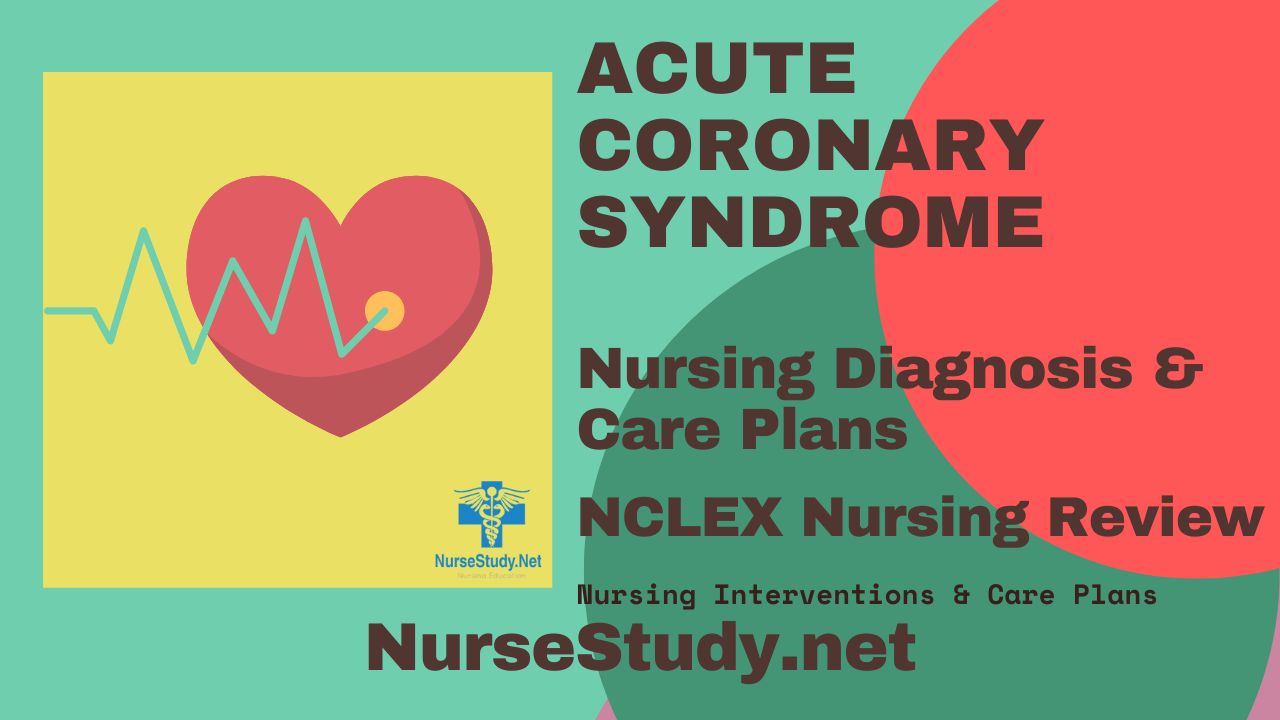Acute Coronary Syndrome (ACS) refers to a spectrum of conditions caused by a sudden reduction of blood flow to the heart muscle.
This term includes unstable angina, NSTEMI, and STEMI, which share similar pathophysiologic origins — usually plaque rupture and thrombus formation within coronary arteries.
For nurses, early recognition and prompt intervention are critical. ACS represents a life-threatening emergency that requires rapid assessment, immediate management, and ongoing patient education.
Nursing students preparing for the NCLEX must understand not only how to identify the condition but also how to develop and implement nursing care plans that promote perfusion, relieve pain, and prevent complications.
Focused Assessment Cues and Diagnostics
Assessment Findings:
- Sudden chest pain or pressure radiating to the left arm, neck, jaw, or back
- Diaphoresis, anxiety, pallor, and shortness of breath
- Nausea or vomiting
- Irregular or weak pulse
- Hypotension or hypertension
Diagnostic Tests:
- Electrocardiogram (ECG): Detects ischemic or infarction changes (ST elevation or depression)
- Cardiac biomarkers: Elevated troponin I/T, CK-MB
- Echocardiogram: Assesses ventricular function
- Coronary angiography: Identifies blockages or occlusions
Pathophysiology Summary
Acute Coronary Syndrome occurs when an atherosclerotic plaque within a coronary artery ruptures, triggering platelet aggregation and thrombus formation.
This results in reduced myocardial oxygen supply and ischemia. Prolonged ischemia leads to cellular death (infarction). The severity depends on the size and location of the blockage, collateral circulation, and duration of occlusion.
Nursing Care Plans for Acute Coronary Syndrome
Nursing Care Plan #1
Nursing Diagnosis: Acute Pain related to myocardial ischemia
Related Factors: Decreased oxygen supply to myocardial tissue
Nursing Interventions and Rationales:
- Assess pain characteristics (location, duration, intensity) to evaluate ischemic changes.
- Administer oxygen to improve oxygenation and decrease myocardial workload.
- Provide prescribed nitroglycerin or morphine as ordered to relieve pain and reduce anxiety.
- Maintain bed rest to reduce oxygen consumption.
- Educate patient to report new or worsening pain immediately.
Desired Outcomes:
The patient reports pain relief, maintains stable vital signs, and demonstrates relaxation.
Nursing Care Plan #2
Nursing Diagnosis: Decreased Cardiac Output related to impaired myocardial contractility
Related Factors: Myocardial damage following ischemia or infarction
Nursing Interventions and Rationales:
- Monitor heart rate, rhythm, and blood pressure continuously.
- Administer medications such as beta-blockers or ACE inhibitors as prescribed.
- Maintain IV access for emergency medication administration.
- Monitor urine output and mental status as indicators of perfusion.
- Encourage gradual activity as tolerated.
Desired Outcomes:
The patient maintains adequate cardiac output as evidenced by stable hemodynamics and improved activity tolerance.
Nursing Care Plan #3
Nursing Diagnosis: Ineffective Cardiac Tissue Perfusion related to coronary artery occlusion
Related Factors: Blockage from thrombus or plaque
Nursing Interventions and Rationales:
- Position patient in semi-Fowler’s to enhance ventilation.
- Administer oxygen therapy per protocol.
- Prepare for and assist during reperfusion therapy (thrombolytics or PCI).
- Assess peripheral pulses and skin color for perfusion changes.
- Educate patient on the importance of adherence to medication and follow-up care.
Desired Outcomes:
Patient demonstrates improved perfusion with warm skin, strong pulses, and stable cardiac rhythm.
Nursing Care Plan #4
Nursing Diagnosis: Anxiety related to fear of death and hospitalization
Related Factors: Uncertainty about condition and outcome
Nursing Interventions and Rationales:
- Provide calm reassurance and remain with patient during acute episodes.
- Explain all procedures and treatments clearly.
- Encourage the patient to verbalize feelings and concerns.
- Limit unnecessary stimulation; promote a quiet environment.
Desired Outcomes:
The patient expresses reduced anxiety and participates actively in care.
Nursing Care Plan #5
Nursing Diagnosis: Deficient Knowledge related to new diagnosis and treatment regimen
Related Factors: Lack of information about lifestyle changes and medications
Nursing Interventions and Rationales:
- Assess the patient’s current understanding of ACS and medications.
- Provide written materials about prescribed medications, diet, and exercise.
- Teach signs of complications (e.g., chest pain recurrence, shortness of breath).
- Reinforce importance of medication adherence and smoking cessation.
Desired Outcomes:
The patient verbalizes understanding of disease management and demonstrates proper self-care behaviors.
Patient Education & Safety
- Medication adherence: Continue aspirin, beta-blockers, and statins as prescribed.
- Lifestyle modification: Adopt a heart-healthy diet, stop smoking, and maintain regular exercise after recovery.
- Emergency action: Report any chest pain, palpitations, or shortness of breath immediately.
- Follow-up: Attend cardiac rehabilitation and routine medical appointments.
FAQ
1. What are the priority nursing diagnoses for Acute Coronary Syndrome?
Acute pain, decreased cardiac output, and ineffective cardiac tissue perfusion are top priorities.
2. Which nursing interventions are most critical in ACS?
Immediate oxygen therapy, ECG monitoring, administration of nitrates, and rapid initiation of reperfusion therapy.
3. How can nurses educate patients post-ACS?
By emphasizing medication adherence, risk factor modification, and recognizing early warning signs.
4. What is the difference between ACS and myocardial infarction?
ACS encompasses unstable angina, NSTEMI, and STEMI — with MI representing the more severe end where tissue necrosis occurs.
Peer-Reviewed References
- Brunner & Suddarth’s Textbook of Medical-Surgical Nursing, 15th ed.
- Lewis et al. Medical-Surgical Nursing: Assessment and Management of Clinical Problems, 12th ed.
- Smeltzer & Bare. Brunner and Suddarth’s Textbook of Medical-Surgical Nursing.
- Ignatavicius & Workman. Medical-Surgical Nursing: Concepts for Interprofessional Collaborative Care, 10th ed.
- American Heart Association. Guidelines for the Management of Acute Coronary Syndromes, 2023.
